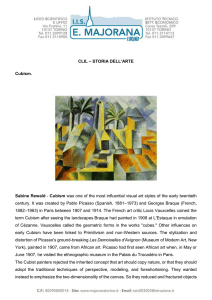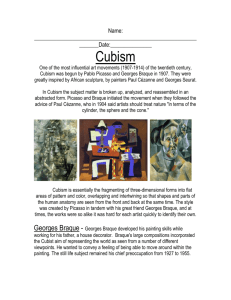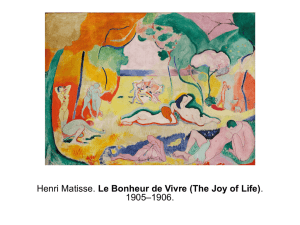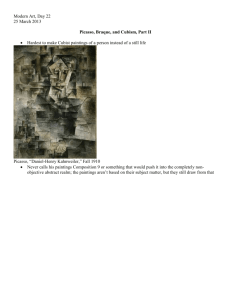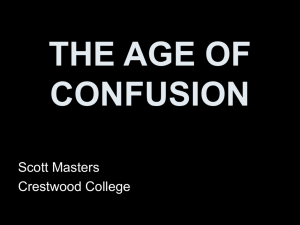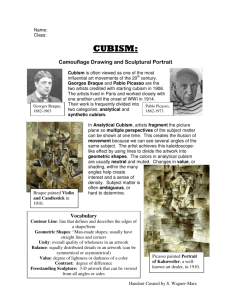Woman Combing Her Hair
advertisement
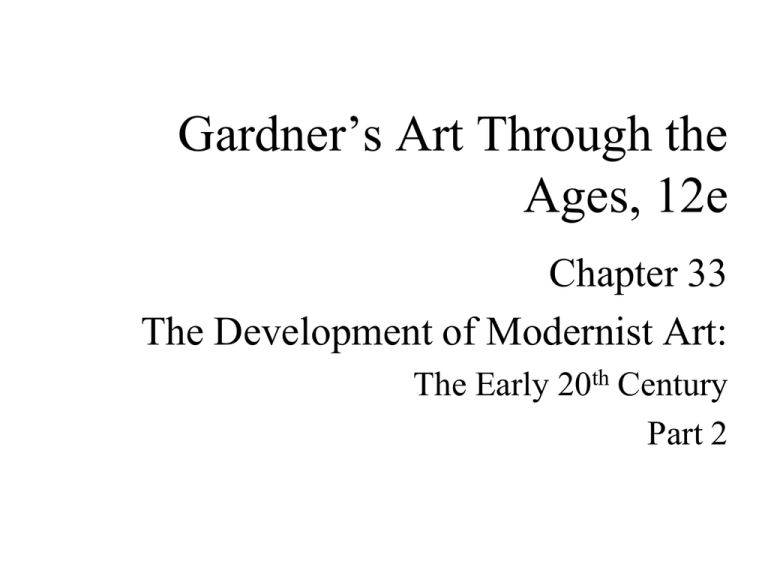
Gardner’s Art Through the Ages, 12e Chapter 33 The Development of Modernist Art: The Early 20th Century Part 2 Colonial Empires About 1900 Cubism in Europe • The most talked about “ism” of twentieth-century art, Cubism was the joint invention of Pablo Picasso and Georges Braque. • The first branch of cubism, known as "Analytic Cubism", was both radical and influential as a short but highly significant art movement between 1907 and 1911 in France. In its second phase, Synthetic Cubism, (using synthetic materials in the art) the movement spread and remained vital until around 1919, when the Surrealist movement gained popularity. • In cubist artworks, objects are broken up, analyzed, and re-assembled in an abstracted form—instead of depicting objects from one viewpoint, the artist depicts the subject from a multitude of viewpoints to represent the subject in a greater context. Often the surfaces intersect at seemingly random angles, removing a coherent sense of depth. The background and object planes interpenetrate one another to create the shallow ambiguous space, one of cubism's distinct characteristics. Picasso’ Early Art • The Spanish born artist Pablo Picasso is generally seen as the most important artist of the twentieth century. Trained first in Barcelona, Picasso made frequent extended visits to Paris in 1900 and moved there in early 1904. • Picasso’s work is often categorized into periods. While the names of many of his later periods are debated, the most commonly accepted periods in his work are the Blue Period (1901—1904), the Rose Period (1905--1907), the African-influenced Period (1908—1909), Analytic Cubism (1909—1912), and Synthetic Cubism (1912—1919). • Most of the paintings from Picasso’s Blue period are sad, focusing on human misery. He paints the blind, beggars, alcoholics, and prostitutes. One of Picasso’s friends committed suicide during this time, and it may have been from this grief and sadness that Picasso chose such emotional subjects for his paintings. Pablo Picasso, The Tragedy, 1903 Stein, 1906–1907. Oil on canvas. Along with her brother Leo, Gertrude Stein was among the first Americans to respond with enthusiasm to the artistic revolution in Europe in the early years of the twentieth century. Picasso's portrait of the expatriate writer was begun in 1905. Picasso actually completed the head after a trip to Spain in fall 1906. His reduction of the figure to simple masses and the face to a mask with heavy lidded eyes reflects his recent encounter with African, Roman, and Iberian sculpture and foreshadows his adoption of Cubism. The Development of Cubism • Picasso’s African-influenced Period (1907–1909) begins with the two figures on the right in his painting, Les Demoiselles d’Avignon, which were inspired by African artifacts. Formal ideas developed during this period lead directly into the Cubist period that follows. • Analytic cubism (1909–1912) is a style of painting Picasso developed along with Georges Braque using monochrome brownish and neutral colors. Both artists took apart objects and “analyzed” them in terms of their shapes. Picasso and Braque’s paintings at this time have many similarities. • Synthetic cubism (1912–1919) was a further development of the genre, in which cut paper fragments—often wallpaper or portions of newspaper pages—were pasted into compositions, marking the first use of collage in fine art. PABLO PICASSO, Les Demoiselles d’Avignon, June–July 1907. Picasso was not consciously trying to break with the western pictorial tradition that dated back to Giotto, but he did. Braque responded eagerly to Picasso’s formal innovations. GEORGES BRAQUE, The Portuguese, 1911. In The Portuguese, an example of Analytic Cubism, Georges Braque dissected the form of the image (a man and his guitar) and placed it in dynamic interaction with the space around it. ROBERT DELAUNAY, Champs de Mars or The Red Tower, 1911. Illusion or reality?: The second phase of Cubism is called Synthetic Cubism, in which artists constructed paintings and drawings from objects and shapes cut from paper or other materials to represent parts of a subject. Picasso's Still Life with ChairCaning includes a piece of oilcloth pasted on the canvas after it was imprinted with the photolithographed pattern of a cane chair seat. The picture is framed with a piece of rope. Georges Braque's Fruit Dish and Cards is a variant of collage called papier collé (stuck paper) that involved gluing assorted paper shapes to a drawing or painting. PABLO PICASSO, Still Life with Chair-Caning, 1912. GEORGES BRAQUE, Bottle, Newspaper, Pipe and Glass, 1913. Charcoal and various papers pasted on paper PABLO PICASSO, Maquette for Guitar, 1912. Cardboard, string, and wire (restored), 25 1/4” x 13” x 7 1/2”. Museum of Modern Art, New York. Cubist Sculpture • Cubist Sculpture brought the simplified shapes of Cubist painting together with the three dimensional modeling medium of sculpture. The first Cubist sculpture was made by Picasso in 1909 and was titled 'Head of a Woman'. However Picasso did experiment with abstract sculpture as early as 1907 when he discovered, and was influenced by, African masks. Cubist sculpture was mostly reminiscent of Analytical Cubism in its stripping away of illusionist details to reveal the fundamental form contained in each individual subject, be it human or still-life. • Sculptors like Jacques Lipschitz, Aleksandr Archipenko, and Julio Gonzalez further developed these ideas. JACQUES LIPCHITZ, Bather, 1917. Bronze, One of the most successful sculptors to adapt into three dimensions the planar, fragmented dissolution of form central to Analytic Cubist painting was JAQUES LIPCHITZ. ALEKSANDR ARCHIPENKO, Woman Combing Her Hair, 1915. Bronze, approx. 1’ 1 3/4” high. Museum of Modern Art, New York In his quasi-representational statuette Woman Combing Her Hair, Aleksandr Archipenko shows a complex interpenetration of space and mass. JULIO GONZÁLEZ, Woman Combing Her Hair, ca. 1930–1933. Iron, 4’ 9” high. Moderna Museet, Stockholm. In his almost completely abstract welded iron sculpture Woman Combing Her Hair, Julio González reduced form to an dynamic interplay of curves, lines, and planes.


